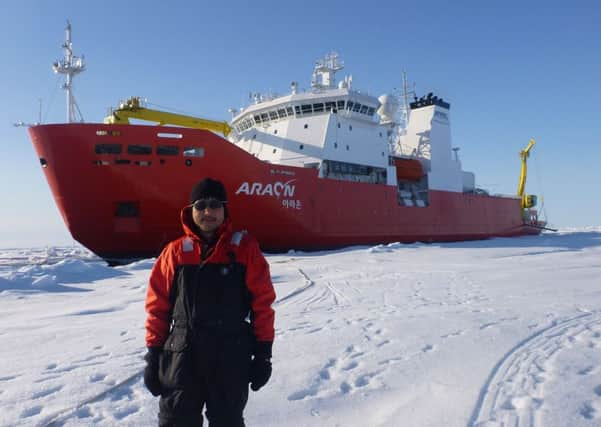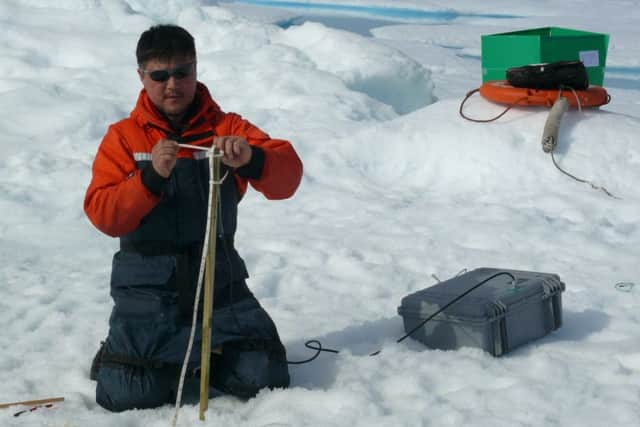Yorkshire scientist joins £100m climate change mission to the Arctic


Dr Byongjun ‘Phil’ Hwang is no stranger to the Arctic having been to the northernmost part of Earth more than a dozen times before. But his latest trip is likely to be the most significant of all as the geophysicist joins hundreds of fellow scientists and researchers from 17 countries in a ground-breaking £100m project to examine its changing conditions – and their effect on global weather patterns.
Warmer temperatures in the Arctic, which has led to record levels of melting sea ice, is already believed to be having an considerable impact on the world’s weather, with a recent study published in journal Nature Communications suggesting it had led to more severe winter weather in eastern America and the ‘Beast from the East’ which affected the UK and Europe earlier this year through the impact on air pressure.
Advertisement
Hide AdAdvertisement
Hide AdBut while warming rates in the Arctic are twice the global average, its precise impact on the global climate remains a hotly-debated subject among scientists, as modern climate models are currently unable to reproduce Arctic climate change due to a lack of available data which has been limited by a lack of year-round observations in the central Arctic.


This milestone mission, starting in September 2019 and led by Germany’s Alfred Wegener Institute, intends to change that.
A research icebreaker ship called Polarstern will depart from Norway and spend the next year drifting through the Arctic Ocean, trapped in the ice. The ship is expected to drift south for more than 700 miles but the Polarstern will not move under its own power. Instead, it will be carried by the ice for an average distance of about six miles a day, with the speed of the flow being more rapid in the summer.
It is hoped the project, known as the Multidisciplinary drifting Observatory for the Study of Arctic Climate – or MOSAiC for short – will provide a “quantum leap” in understanding of Arctic climate change through direct observations of the atmosphere, ocean, sea ice, bio-geochemistry and ecosystem.
Advertisement
Hide AdAdvertisement
Hide AdThe new knowledge will be used around the world to improved weather and climate predictions, helping to develop policies to mitigate its impact and also informing decisions on fishing and freight traffic in northern sea routes.
Dr Hwang, a senior lecturer in physical geography at the University of Huddersfield, will now be among the hundreds of scientists taking part, following the UK Government-backed Natural Environment Research Council agreeing to provide almost £300,000 in funding so he can participate in MOSAiC.
Dr Hwang, who is originally from South Korea and moved to Yorkshire earlier this year having previously worked in Canada and Scotland, has already made 15 voyages to the region, observing, recording and analysing seasonal changes in the ice and will send his equipment out on the voyage from its beginning, joining the mission himself for two months in 2020.
The precise arrangements are yet to be confirmed but it is likely he will set out from a departure point in northern Europe or Russia and be ferried to the research vessel either by another icebreaker ship or a helicopter.
Advertisement
Hide AdAdvertisement
Hide AdThe 49-year-old says he is delighted to playing a part in such an important project, where his focus will be on analysing declining sea ice. He will take with him some specially-designed and constructed buoys equipped with GPS devices that are capable of tracking the movement of ice with extreme precision.
He says he has always found being in the Arctic an incredible experience, ever since his first visit back in 2002. “It was amazing, the visit was part of a big Canadian project,” he explains. “My first trip was wonderful. Going out on the ice is the most wonderful experience, it is like being in the wild. It is very quiet, very peaceful and interesting. When we were coming back, I was talking to other people with more experience who were a bit glum but I couldn’t stop smiling. They were asking ‘Why are you so happy?’
“It depends where you go in the Arctic what it is like – everyone will have different experiences. If you go in the summer, it can be 10C, with 24-hour sun. But it winter, it can be very cold, almost -60C.”
But Hwang says the ongoing disappearance of sea ice has been clear over the course of his visits, particularly in recent years. “Between 2010 and 2015, I saw big changes. One of the big changes is that you don’t see thick second layer ice which survives the melting in the summer and regenerates. This type of ice is disappearing.
Advertisement
Hide AdAdvertisement
Hide Ad“Because the Arctic sea ice is declining, 20 to 30 years ago, you would see solid ice all around. Now you go and see smaller pieces of ice floating around. Waves used to not be that strong because of the ice but now you see strong waves coming.”
Hwang says continuing global temperature rises could ultimately result in ‘ice-free summers’ in the Arctic. The extent of the melting ice has been demonstrated this week, as a 42,000-tonne commercial container ship crosses an Arctic route between Vladivostok and St Petersburg for the first time in history.
Hwang says he hopes his work on the mission will contribute to a better understanding of what is happening – and how society can react. “I have a very specific objective,” he says. “We are trying to measure the dynamics of the ice, how the ice is breaking up throughout winter to springtime.
“The fundamental aim of this exploration mission is feeding all the observational data into the climate model so we can predict the future more accurately. We have satellite observation that can see what is happening alongside the ship. But if we want to measure how the individual ice is breaking up and melting, satellite cannot resolve that.
Advertisement
Hide AdAdvertisement
Hide Ad“In simple terms, we have to be there to go and measure it.”
Hwang’s findings will be jointly investigated by Dr Jinchang Ren, of the University of Strathclyde – an image processing specialist who will remain in the UK – on assessing seasonal ice floes which increasingly see winter ice deforming and then breaking up in the spring and melting in the summer. He will also appoint one PhD researcher at Huddersfield to help him work with his findings.
Before his recent move to Yorkshire to expand his research topics, develop his teaching career and contribute to a curriculum of new geography degree courses at the University of Huddersfield, Hwang previously worked for the Scottish Association for Marine Science.
“When I talked to friends in Scotland, they said Yorkshire is OK but don’t go any further south!”
Advertisement
Hide AdAdvertisement
Hide AdInstead, Dr Hwang will soon be leaving his new home to head to the far north once again – on a mission with major implications for the future of mankind.
Project recalls 19th Century expedition
The MOSAiC project takes its inspiration from an expedition of the 1890s, when Norwegian explorer Fridtjof Nansen attempted to reach the North Pole by allowing his vessel to be frozen into the ice.
While Nansen has demonstrated the basic concept of letting a research vessel drift across the polar cap, the scientific measurements at that time were extremely limited.
The Polarstern will enter the Siberian sector of the Arctic in thin sea ice conditions in late summer, with a distributed regional network of observational sites will be set up on the sea ice in an area of up to 50km distance. The ship and surrounding network will drift with the natural ice drift across the polar cap towards the Atlantic, while the sea ice thickens during winter.